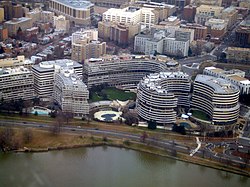New York Times Co. v. United States: Difference between revisions
m Removed nonsense by 138.23.89.87 |
The page did not mention the outcome of the case, so I added it. Somebody should probably elaborate since I am not an expert on this or related matters. |
||
| Line 2: | Line 2: | ||
'''''New York Times Co. v. United States''''', 403 U.S. 713 ([[1971]]) was a [[Supreme Court of the United States|United States Supreme Court]] ''[[per curiam]]'' decision. The ruling made it possible for the ''[[New York Times]]'' and ''[[Washington Post]]'' newspapers to publish the then-[[classified information|classified]] [[Pentagon Papers]] without risk of government censure. |
'''''New York Times Co. v. United States''''', 403 U.S. 713 ([[1971]]) was a [[Supreme Court of the United States|United States Supreme Court]] ''[[per curiam]]'' decision. The ruling made it possible for the ''[[New York Times]]'' and ''[[Washington Post]]'' newspapers to publish the then-[[classified information|classified]] [[Pentagon Papers]] without risk of government censure. |
||
In the midst of the [[Watergate scandal]], the ''Times'' case featured a [[constitutional crisis]] in which the U.S. [[President]] [[Richard Nixon]] had claimed [[executive (government)|executive]] authority to force the prominent newspaper to [[publication ban|suspend publication]] of [[classified information]] in its possession. The question before the court was if the constitutional [[freedom of the press]] under the [[First Amendment]] was subordinate to a claimed Executive need to maintain the secrecy of information. |
In the midst of the [[Watergate scandal]], the ''Times'' case featured a [[constitutional crisis]] in which the U.S. [[President]] [[Richard Nixon]] had claimed [[executive (government)|executive]] authority to force the prominent newspaper to [[publication ban|suspend publication]] of [[classified information]] in its possession. The question before the court was if the constitutional [[freedom of the press]] under the [[First Amendment]] was subordinate to a claimed Executive need to maintain the secrecy of information. The supreme court ruled that First Amendment did protect the New York Times's right to print said materials. |
||
==Research Resources== |
==Research Resources== |
||
Revision as of 03:54, 15 January 2006
| Watergate scandal |
|---|
 |
| Events |
| People |
New York Times Co. v. United States, 403 U.S. 713 (1971) was a United States Supreme Court per curiam decision. The ruling made it possible for the New York Times and Washington Post newspapers to publish the then-classified Pentagon Papers without risk of government censure.
In the midst of the Watergate scandal, the Times case featured a constitutional crisis in which the U.S. President Richard Nixon had claimed executive authority to force the prominent newspaper to suspend publication of classified information in its possession. The question before the court was if the constitutional freedom of the press under the First Amendment was subordinate to a claimed Executive need to maintain the secrecy of information. The supreme court ruled that First Amendment did protect the New York Times's right to print said materials.
Research Resources
External links
- Text of the decision, 403 US 713
